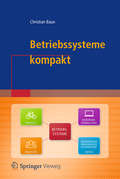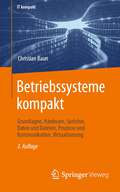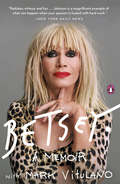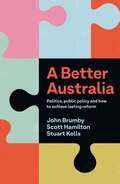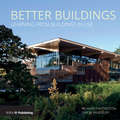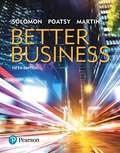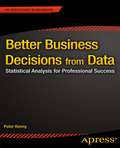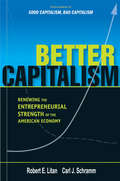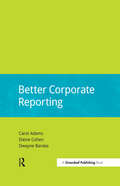- Table View
- List View
Betriebsräte in Deutschland: Vom Arbeiterausschuss zum Mitgestalter des Arbeitslebens
by Horst-Udo NiedenhoffDie Bundesrepublik Deutschland ist im internationalen Vergleich das Land mit den meisten Mitbestimmungsgesetzen. Nirgendwo sonst sind die Rechte der Arbeitnehmer so weitgehend geregelt wie hier. Und das bereits seit über 100 Jahren! Im Mittelpunkt dieser Mitbestimmung stehen die Mitwirkungs-und Mitbestimmungsrechte der Betriebsräte in sozialen, personellen und wirtschaftlichen Angelegenheiten. Von einer partnerschaftlichen und qualifizierten Zusammenarbeit von Arbeitgeber und Betriebsrat hängt der wirtschaftliche Erfolg eines Unternehmens in hohem Maße ab. Für den Wirtschaftsstandort Deutschland ist daher eine funktionierende Betriebspartnerschaft ein Kernelement der Wettbewerbsfähigkeit. In der Schrift „Betriebsräte in Deutschland“ sollen der Begriff der Mitbestimmung erläutert werden und die rechtliche und politische Entwicklung der Arbeitnehmervertretung Betriebsrat vom Arbeiterausschuss vor über 100 Jahren bis zum Mitgestalter des heutigen und künftigen Arbeitslebens. Im Mittelpunkt der Abhandlung steht die Entwicklung des Betriebsratsamtes und seine heutigen Mitwirkungs-und Mitbestimmungsrechte im Betrieb und Unternehmen. Dazu gehören ebenso die Verquickung von betrieblicher Mitbestimmung und Unternehmenspolitik durch Betriebsräte in den Aufsichtsräten der Kapitalgesellschaften und im Europäischen Betriebsrat Ein weiterer Schwerpunkt des Buches sind die Perspektiven der betrieblichen Mitbestimmung und die damit verbundenen Anforderungen an die Betriebsratsarbeit in der digitalen Arbeitswelt. Der Betriebsrat ist „Sprachrohr“ der Arbeitnehmer und gleichzeitig Mittler zwischen Arbeitgebern und Arbeitnehmern. Er ist Meinungsbildner im täglichen Arbeitsablauf im Betrieb. Somit ist er interessant für betriebsexterne Gruppen wie zum Beispiel Gewerkschaften und politische Parteien, um Werbung für ihre Politik zu betreiben. Betriebsräte als Multiplikatoren politischer Meinungen sind daher ebenso ein Gegenstand dieser Untersuchung. Beschrieben werden zu dem der „typische“ Betriebsrat. Die Kosten der Anwendung des Betriebsverfassungsgesetzes und der Betriebsrat im Spiegel empirischer Untersuchungen sind weitere ergänzende Themen. Eine Erkenntnis aus der Entwicklung des Betriebsrats als volkswirtschaftlicher Produktionsfaktor ist, dass es bei der Diskussion um die betriebliche Mitbestimmung nicht mehr um das „Ob“, sondern um das „Wie“ in der Zusammenarbeit von Arbeitgeber und Betriebsrat handelt.
Betriebsstätten in Russland: Unternehmerische Betätigung in der Russischen Föderation
by Daria PfeilerRussland wird für deutsche Unternehmen zunehmend attraktiv. Nicht zuletzt aufgrund der Olympiade 2014 in Sotchi und der Fußball WM 2018 finden Investitionen im Milliarden-Bereich statt. Die rechtliche und steuerrechtliche Systematisierung in Russland zu verstehen und richtig anwenden wird damit für den wirtschaftlichen Erfolg immer wichtiger.
Betriebssysteme kompakt (IT kompakt)
by Christian BaunSpeicherverwaltung, Hardwareverwaltung, Prozessadministration und Interprozesskommunikation sind zentrale Bereiche von Betriebssystemen. Die Konzepte und Prinzipien, auf denen klassische und moderne Betriebssysteme basieren, erl#65533;utert der Autor anhand von einschl#65533;gigen Aufgabenstellungen und L#65533;sungen. Das Werk gibt damit eine verst#65533;ndliche Einf#65533;hrung in die Architektur von Betriebssystemen und eignet sich deshalb auch f#65533;r die Lehre im Bachelorstudium.
Betriebssysteme kompakt: Grundlagen, Daten, Speicher, Dateien, Prozesse und Kommunikation (IT kompakt)
by Christian BaunSpeicherverwaltung, Hardwareverwaltung, Prozessadministration und Interprozesskommunikation sind zentrale Bereiche von Betriebssystemen. Die Konzepte und Prinzipien, auf denen klassische und moderne Betriebssysteme basieren, erläutert der Autor anhand von einschlägigen Aufgabenstellungen und Lösungen. Das Werk gibt damit eine verständliche Einführung in die Architektur von Betriebssystemen und eignet sich deshalb auch für die Lehre im Bachelorstudium.
Betriebssysteme kompakt: Grundlagen, Hardware, Speicher, Daten und Dateien, Prozesse und Kommunikation, Virtualisierung (IT kompakt)
by Christian BaunSpeicherverwaltung, Hardwareverwaltung, Prozessadministration und Interprozesskommunikation sind zentrale Aufgaben von Betriebssystemen. Die Konzepte und Prinzipien, auf denen klassische und moderne Betriebssysteme basieren, erläutert der Autor anhand von einschlägigen Aufgabenstellungen und Lösungen. Das Werk gibt damit eine verständliche Einführung in die Architektur von Betriebssystemen und eignet sich deshalb auch für die Lehre im Bachelorstudium.
Betriebswirtschaft im öffentlichen Sektor: Eine Einführung
by Michael MroßDie Öffentliche Betriebswirtschaftslehre befasst sich mit Institutionen, die Güter für die Allgemeinheit bereitstellen und damit öffentliche Aufgaben erfüllen. Dieses Buch bietet einen anschaulichen und kompakten Einstieg in die Betriebswirtschaftslehre am Beispiel des öffentlichen Sektors. Der Aufbau entspricht den betriebswirtschaftlichen Grundfunktionen Finanzierung, Beschaffung, Marketing, Rechnungswesen, Produktion und Management. Jedes Kapitel enthält Wiederholungsfragen zur Anregung eigener Überlegungen und zur gezielten Prüfungsvorbereitung.
Betriebswirtschaftliche Aspekte von Industrie 4.0 (ZfbF-Sonderheft #71/17)
by Mischa Seiter Lars Grünert Sebastian BerlinDas Sonderheft der ZfbF stellt die Ergebnisse des Arbeitskreises "Integrationsmanagement neuer Produkte" der Schmalenbach-Gesellschaft dar und zeigt facettenreich auf, wie umfassend die betriebswirtschaftliche Forschung bei der L#65533;sung der aufkommenden unternehmerischen Fragestellungen durch Industrie 4. 0 mitwirken kann. Industrie 4. 0 besch#65533;ftigt seit einigen Jahren die deutschen Unternehmen als eines von zehn Zukunftsprojekten der Bundesregierung. Die Untersuchung der betriebswirtschaftlichen Auswirkungen dieser Entwicklungen bildete, bis auf wenige Ausnahmen, einen Randaspekt der Forschung. Allerdings verursachten Industrie 4. 0-Initiativen in den letzten Jahren bereits weitreichende betriebswirtschaftliche Konsequenzen, die zum Teil ganze Branchen ver#65533;nderten. Wortmann, Bilgeri, Weinberger und Fleisch beleuchten die Entwicklung von Ertragsmodellen im Internet of Things. Die Autoren Gr#65533;nert und Sejdic leiten zun#65533;chst einen Bezugsrahmen f#65533;r Industrie 4. 0-getriebene Gesch#65533;ftsmodellinnovation ab. Kersten, Schr#65533;der und Indorf analysieren die Auswirkungen der Digitalisierung auf das Supply Chain Risikomanagement. Butschan, Nestle, Munck und Gleich befassen sich mit dem Kompetenzaufbau zur Umsetzung von Industrie 4. 0 in der Produktion. Schlie#65533;lich arbeiten Obermaier und Grottke die Herausforderungen von ,,Industrie 4. 0"-Technologien f#65533;r das Controlling heraus und zeigen das Potential dieser Technologien f#65533;r das Controlling auf.
Betriebswirtschaftliche Herausforderungen im Planungsbüro: Schnelleinstieg für Architekten und Bauingenieure (essentials)
by Dietmar GoldammerDietmarGoldammer zeigt wie sich Architektur- und Ingenieurbüros auf veränderteArbeitswelten, soziale Verantwortung und Nachhaltigkeit als neueHerausforderungen einstellen müssen. Der Autor beschreibt Frühwarnsysteme,Zertifizierungen und neue Organisationsformen, die dabei helfen. Erthematisiert auch, wie die Regelung der Nachfolge des Unternehmers ausgestaltetwerden kann. So zeigt sich: Der gesellschaftliche Wandel ist auch in denPlanungsbüros angekommen. Es wäre ein Leichtsinn zu glauben, dass dort alles soweiter geht wie bisher. Das Essential hilft kurz und prägnant, die richtigenSchritte anzustoßen.
Betriebswirtschaftliche KI-Anwendungen: Digitale Geschäftsmodelle auf Basis Künstlicher Intelligenz
by Christian Aichele Jörg HerrmannDigitalisierung und Künstliche Intelligenz ermöglichen Unternehmen disruptive Erweiterungen ihrer Geschäftsmodelle. Wer rechtzeitig digitale KI-Geschäftsmodelle einführt, wird seinen Erfolg nachhaltig sichern können. Aber wie und wo können solche Modelle Anwendung finden? Diese Publikation gibt Antworten, wo KI-Geschäftsmodelle greifen können, und wie diese von der ersten Idee bis zur produktiven Anwendung realisiert werden können.
Betriebswirtschaftliche KI-Anwendungen: Digitale Geschäftsmodelle auf Basis Künstlicher Intelligenz
by Christian Aichele Jörg HerrmannDigitalisierung und Künstliche Intelligenz ermöglichen Unternehmen disruptive Erweiterungen ihrer Geschäftsmodelle. Wer rechtzeitig digitale KI-Geschäftsmodelle einführt, wird seinen Erfolg nachhaltig sichern können. Aber wie und wo können solche Modelle Anwendung finden? Diese Publikation gibt Antworten, wo KI-Geschäftsmodelle greifen können, und wie diese von der ersten Idee bis zur produktiven Anwendung realisiert werden können.
Betriebswirtschaftslehre - Schnell erfasst (Wirtschaft – Schnell erfasst)
by Claudia Kocian-DirrWas hat Betriebswirtschaftslehre mit Mr. Spock, dem Boxenstopp in der Formel EIns und dem Elefanten im Kühlschrank zu tun? Dieses Lehrbuch ist genau richtig für alle, die verständlich und kompakt erfahren wollen, worum es in der Betriebswirtschaftslehre genau geht, wie ein Unternehmen grundsätzlich funktioniert, wie Unternehmen in der Wertschöpfungskette zusammenarbeiten und welche Entscheidungen in Unternehmen getroffen werden müssen. Und natürlich, was Management, Unternehmensstrategien und Controlling beinhalten. Wer nach den ersten Kapiteln ein Fan der Betriebswirtschaftslehre geworden ist, kann sich in speziellen Kapiteln in alle betriebliche Funktionen vertiefen wie Innovationsmanagement, Produktionswirtschaft, Personalmanagement oder Informationsmanagement. Abgerundet wird das Buch durch ein Methoden-Kit, das die wichtigsten Methoden für die Lösung von betrieblichen Problemen bereithält. Alles ist einprägsam in zahlreichen Abbildungen visualisiert und mit Beispielen erläutert. Zum Abschluss eines jeden Kapitels gibt es Wiederholungs- und Vertiefungsfragen mit Musterlösungen, um das erworbene Wissen zu überprüfen und anzuwenden. Das Grundlagenbuch wendet sich an Studierende in Bachelor- und Masterstudiengängen sowie an Praktiker, die sich Basiswissen aneignen oder vorhandenes Wissen auffrischen möchten.
Betriebswirtschaftslehre für Umweltwissenschaftler
by Ado AmpofoDieses Lehrbuch vermittelt Grundkenntnisse im Bereich der Betriebswirtschaftslehre für praxisnah ausgebildete Umweltwissenschaftler. Ein erfolgreiches Agieren als Mitarbeiter mit eigenem Verantwortungsbereich in einem Unternehmen ist ohne betriebswirtschaftliches Wissen praktisch unmöglich. Dies macht es für Fach- und Führungskräfte erforderlich, sich mit den grundlegenden Vorgängen und Zusammenhängen auseinanderzusetzen. Der Autor erläutert mit praxisrelevantem Fokus die Themenbereiche Marketing, Rechnungswesen, Rechtsformen, Forderungsmanagement, Steuern sowie Projekt- und Qualitätsmanagement. Auch die grundlegenden Herausforderungen des Umweltmanagements werden dargestellt. Ein ausführlicher Aufgabenteil mit Lösungen am Ende des Buches unterstützt die Lernkontrolle. Das Buch richtet sich an Umweltwissenschaftler, Umwelttechniker und Umweltingenieure, die die Grundlagen der Betriebswirtschaft erlernen möchten.
Betsey: A Memoir
by Betsey Johnson Mark VitulanoA memoir by the internationally famous fashion designer and style iconMention the name "Betsey Johnson" and almost every woman from the age of 15 to 75 can rapturously recall a favorite dress or outfit; whether worn for a prom, a wedding, or just to stand out from the crowd in a colorful way. They may also know her as a renegade single mom who palled around with Edie Sedgwick, Twiggy, and The Velvet Underground, or even as a celebrity contestant on Dancing with the Stars. Betsey is also famous for her iconic pink stores (she had 65 shops across the US) and for her habit of doing cartwheels and splits down the runway at the close of her fashion shows. Throughout her decades-long career, she's taken pride in producing fun but rule-breaking clothing at an accessible price point. What they might not know is that she built an empire from scratch, and brought stretch clothing to the masses in the 80s and 90s. Betsey will take the reader behind the tutu and delve deeply into what it took to go from a white picket fence childhood in Connecticut to becoming an internationally known force in a tough, competitive business. The book will feature Betsey's candid memories of the fashion and downtown scene in the 60s and how she started her own business from the ground up after designing successfully for multiple other companies. She will discuss that business's ups and downs and reinventions (including bankruptcy), and her thoughts on body image, love, divorce, men, motherhood, and her bout with breast cancer. Betsey will be richly illustrated with many of her landmark clothes, fashion sketches, and personal photos--making the book the perfect memento and gift for every girl (of any age) for whom Betsey is, as a recent New York Times profile noted, "a role model still."
Better Australia: Politics, Public Policy and How to Achieve Lasting Reform
by Scott Hamilton Stuart Kells John BrumbyWhat does successful public policy look like, and how has it been achieved in Australia? What strategies are needed to overcome petty partisanship and narrow self-interest? And who gets to decide what a 'better Australia' even looks like? In A Better Australia John Brumby, Scott Hamilton and Stuart Kells examine policy design, implementation and reform, and show what can be achieved when engagement is sincere and intent clear. Leading policymakers and political insiders - Julia Gillard, Malcolm Turnbull, Cheryl Kernot, John Hewson, Ken Wyatt, Christine Milne and more - dissect the development of successful policy in energy, gun control, natural resources taxation, disability insurance, marriage equality, gender equality in the workplace, superannuation, reproductive healthcare reform, Closing the Gap and the pandemic response. A Better Australia takes us behind the scenes of the hard-won policy battles, showing the wide-ranging effects of good policy.
Better Bankers, Better Banks: Promoting Good Business through Contractual Commitment
by Claire A. Hill Richard W. PainterTaking financial risks is an essential part of what banks do, but there's no clear sense of what constitutes responsible risk. Taking legal risks seems to have become part of what banks do as well. Since the financial crisis, Congress has passed copious amounts of legislation aimed at curbing banks' risky behavior. Lawsuits against large banks have cost them billions. Yet bad behavior continues to plague the industry. Why isn't there more change? In Better Bankers, Better Banks, Claire A. Hill and Richard W. Painter look back at the history of banking and show how the current culture of bad behavior--dramatized by the corrupt, cocaine-snorting bankers of The Wolf of Wall Street--came to be. In the early 1980s, banks went from partnerships whose partners had personal liability to corporations whose managers had no such liability and could take risks with other people's money. A major reason bankers remain resistant to change, Hill and Painter argue, is that while banks have been faced with large fines, penalties, and legal fees--which have exceeded one hundred billion dollars since the onset of the crisis--the banks (which really means the banks'shareholders) have paid them, not the bankers themselves. The problem also extends well beyond the pursuit of profit to the issue of how success is defined within the banking industry, where highly paid bankers clamor for status and clients may regard as inevitable bankers who prioritize their own self-interest. While many solutions have been proposed, Hill and Painter show that a successful transformation of banker behavior must begin with the bankers themselves. Bankers must be personally liable from their own assets for some portion of the bank's losses from excessive risk-taking and illegal behavior. This would instill a culture that discourages such behavior and in turn influence the sorts of behavior society celebrates or condemns. Despite many sensible proposals seeking to reign in excessive risk-taking, the continuing trajectory of scandals suggests that we're far from ready to avert the next crisis. Better Bankers, Better Banks is a refreshing call for bankers to return to the idea that theirs is a noble profession.
Better Banking: Understanding and Addressing the Failures in Risk Management, Governance and Regulation (The Wiley Finance Series)
by Franck Viort Adrian DochertyWhy did the financial crisis happen? Why did no one see it coming? And how did our banks lose so much of our money? What's being done to sort out the banking industry? And will it work?These are the questions that industry experts Adrian Docherty and Franck Viort cover in Better Banking: Understanding and Addressing the Failures in Risk Management, Governance and Regulation. They give a clear and thorough run-through of some of the key concepts and developments in banking, to enable the reader to understand better this vital yet perilous industry. Without excessive detail or jargon, they explain the most important issues in risk management, regulation and governance and build a comprehensive description of how failings in these areas resulted in the current financial crisis. In order to make the diagnosis clear, the authors illustrate their descriptions with a series of informative case studies. The book revolves around a critique of the current regulatory developments, which the authors feel will be ineffective in fixing the structural flaws in banking. Crucially, and as the title of the book suggests, they set out their own series of proposals to contribute to the development of a better, safer and more effective banking industry.Docherty and Viort's book fills an important gap in the literature on banking and its role in the current financial crisis. It is at once a history, a primer, a critique and a manifesto. It does not take sides but works through a constructive diagnosis towards ideas that could lead to major improvements in the quality and stability of the financial world.Better Banking: Understanding and Addressing the Failures in Risk Management, Governance and Regulation is a technical yet accessible book that seeks to engage interested readers of all kinds -- students, professionals, bankers and regulators but also politicians and the broader audience of citizens outside the banking industry, who are keen to inform themselves and understand what needs to be done to avoid a repeat of this crisis.
Better Boardrooms: Repairing Corporate Governance for the 21st Century
by Patricia MeredithThis is the third of three books authored by award-winning author Patricia Meredith. Her first book, Catalytic Governance: Leading Change in the Information Age (co-authored by Steve Rosell and Ged Davis) set out a process for leading transformative change, based on the authors’ experience with the Canadian Task Force for the Payments System Review. Her second book, Stumbling Giants: Transforming Canada’s Banks for the Information Age (winner of the 2018 Donner Prize and co-authored with James Darroch) highlighted how ill-prepared the Canadian banks are for the technology tsunami overtaking financial services. To regain their reputation as vibrant enablers of economic growth, Better Boardrooms proposes that a broad cross-section of Canadians – policy makers and regulators, customers, suppliers, investors, and, not least, bankers themselves – work together to create a banking system better suited to the twenty-first century. This new model of governance is based on a collaborative approach which ensures all relevant voices are heard. As boundaries between industries blur and stakeholders gain greater access to information, it is vital that policymakers and regulators, customers and suppliers, investors and managers work together to fix broken boardrooms.
Better Buildings: Learning from Buildings in Use
by Richard Partington Simon BradburyThis book started life as a successor to Sustainable Architecture, published in 2007, which set out to prove that sustainable architecture can indeed both ‘lift the spirit’ as well as save the planet. This fully revised edition seeks to take a step further, exploring how sustainable buildings are occupied and work, and sheds light on the methods used to observe this. Through short essays from thought-leaders and case studies of visually stunning, environmentally ground-breaking projects, Better Buildings provides architects with the inspiration and tools they need to deliver sustainable design.
Better Business (Fifth Edition)
by Michael R. Solomon Kendall Martin MaryAnne PoatsyBetter Business introduces the business content readers need--in a better way. By presenting the material in a stimulating, conversational, question and answer format, the text encourages readers to engage more fully with the material. Throughout the text, unique features illustrate positive and negative outcomes of relevant business ventures, while “Mini Chapters” focus in on key topics in business. The 5th Edition continues to feature updated social media strategies and technologies, reflecting the explosive growth of social media in the contemporary business environment. With Better Business, readers have a powerful learning tool that captures the evolving issues and opportunities of business.
Better Business Decisions from Data: Statistical Analysis for Professional Success
by Peter KennyEveryone encounters statistics on a daily basis. They are used in proposals, reports, requests, and advertisements, among others, to support assertions, opinions, and theories. Unless you're a trained statistician, it can be bewildering. What are the numbers really saying or not saying? Better Business Decisions from Data: Statistical Analysis for Professional Success provides the answers to these questions and more. It will show you how to use statistical data to improve small, every-day management judgments as well as major business decisions with potentially serious consequences. Author Peter Kenny--with deep experience in industry--believes that 'while the methods of statistics can be complicated, the meaning of statistics is not. ' He first outlines the ways in which we are frequently misled by statistical results, either because of our lack of understanding or because we are being misled intentionally. Then he offers sound approaches for understanding and assessing statistical data to make excellent decisions. Kenny assumes no prior knowledge of statistical techniques; he explains concepts simply and shows how the tools are used in various business situations. With the arrival of Big Data, statistical processing has taken on a new level of importance. Kenny lays a foundation for understanding the importance and value of Big Data, and then he shows how mined data can help you see your business in a new light and uncover opportunity. Among other things, this book covers: How statistics can help you assess the probability of a successful outcomeHow data is collected, sampled, and best interpretedHow to make effective forecasts based on the data at handHow to spot the misuse or abuse of statistical evidence in advertisements, reports, and proposalsHow to commission a statistical analysisArranged in seven parts--Uncertainties, Data, Samples, Comparisons, Relationships, Forecasts, and Big Data--Better Business Decisions from Data is a guide for busy people in general management, finance, marketing, operations, and other business disciplines who run across statistics on a daily or weekly basis. You'll return to it again and again as new challenges emerge, making better decisions each time that boost your organization's fortunes--as well as your own.
Better Business Regulation in a Risk Society
by Frank Den Butter Alberto Alemanno André Nijsen Jacopo TorritiThe premise of this volume is that business regulations are expected to grow in the near future as a consequence of the emergence of a "(world) risk society." Risks related to terrorism, climate change, and financial crises, for example, will penetrate all conditions of life. Increasingly, the decisions and actions of some bring about risks for many in this era of globalization. Controlling these risks implies managing the world through high-quality regulation, with a particular emphasis on businesses and financial institutions. Central to this approach is the argument that a major, if not the primary, aim of regulation is to internalize externalities, or in a broader context, to repair market failure. Such repair can only be accomplished when the costs are smaller than the welfare gains. Featuring contributions from researchers and policy analysts from the fields of economics, management, law, sociology, political science, and environmental policy, this book focuses on three major topics: * Social risks and business regulation * Preconditions for better business regulation * Theoretical issues related to better business regulation Collectively, the authors demonstrate that the easier it is for regulated businesses to comply at the lowest costs possible--without jeopardizing the related public goals--the greater the degree of compliance. When successful, the net result is a balance of individual and collective net benefits, and by further implication, sustainable business practice and economic growth.
Better Business: How the B Corp Movement Is Remaking Capitalism
by Christopher MarquisA compelling look at the B Corp movement and why socially and environmentally responsible companies are vital for everyone&’s future Businesses have a big role to play in a capitalist society. They can tip the scales toward the benefit of the few, with toxic side effects for all, or they can guide us toward better, more equitable long-term solutions. Christopher Marquis tells the story of the rise of a new corporate form—the B Corporation. Founded by a group of friends who met at Stanford, these companies undergo a rigorous certification process, overseen by the B Lab, and commit to putting social benefits, the rights of workers, community impact, and environmental stewardship on equal footing with financial shareholders. Informed by over a decade of research and animated by interviews with the movement&’s founders and leading figures, Marquis&’s book explores the rapid growth of companies choosing to certify as B Corps, both in the United States and internationally, and explains why the future of B Corporations is vital for us all.
Better Capitalism
by Robert E. Litan Carl J. SchrammIn the wake of the Great Recession and America's listless recovery from it, economists, policymakers, and media pundits have argued at length about what has gone wrong with the American capitalist system. Even so, few constructive remedies have emerged. This welcome book cuts through the chatter and offers a detailed, nonideological, and practical blueprint to restore the vigor of the American economy. Better Capitalismextends and significantly expands on the insights of the authors' widely praised previous book,Good Capitalism, Bad Capitalism, co-written with William Baumol. InBetter Capitalism,Robert E. Litan and Carl J. Schramm focus on the huge—but often unrecognized—importance of entrepreneurship to overall economic growth. They explain how changes in seemingly unrelated policy arenas—immigration, education, finance, and federal support of university research—can accelerate America's recovery from recession and spur the nation's rate of growth in output while raising living standards. The authors also outline an innovative energy strategy and discuss the potential benefits of government belt-tightening steps. Sounding an optimistic note when gloomy predictions are the norm, Litan and Schramm show that, with wise and informed policymaking, the American entrepreneurial engine can rally and the true potential of the U. S. economy can be unlocked.
Better Corporate Reporting (Doshorts Ser.)
by Carol Adams Elaine Cohen Dwayne BarakaBetter Corporate Reporting outlines the latest frameworks for enhancing non-financial and sustainability reporting. It shows you how to integrate non-financial data into your reporting and overall strategy, creating long-term value, trust and transparency. It includes guides to: the International Integrated Reporting Council's new framework; the Global Reporting Initiative's G4 framework; and a detailed look at the concept at the heart of both of these new frameworks, materiality. It is the compilation of 3 bestselling sustainability guides on sustainability reporting.Understanding Integrated Reporting provides a practical and expert distillation of the new IR framework released by the International Integrated Reporting Council in December 2013. It explains what IR is and how to do it; how it links with other reporting frameworks and what it means in terms of thinking and processes. You'll also get a clear business case for IR and insights and best practice examples from leading integrated reporters. The Global Reporting Initiative (GRI) G4 Sustainability Reporting Framework was launched in May 2013. In Understanding G4, corporate reporting veteran Elaine Cohen presents an easy-to-follow review of everything any organization needs to know to decide whether to use the G4 Framework and if so, how. Materiality is the lynch-pin that can align your sustainability initiatives with your overall strategy. Making Sustainability Matter shows you how to identify your organization's most material sustainability issues, allocate resources to sustainability initiatives for optimal returns; connect your communications and reporting to materiality, and; clarify which issues are important to your stakeholders. Materiality is a core concept in both the GRI's new G4 framework the IIRC's new Integrated Reporting framework.
Better Customer Service: Simple Rules You Can Apply Today
by Edward C. Brewer Terence L. HolmesThis readable and concise research-based book discusses seven simple rules that will help businesses and individuals improve their customer satisfaction and workplace environments – and make the world a little better and more pleasant. An author team with extensive cross-sector experience provides a foundation that will help improve customer service no matter the type of organization or situation, allowing customization according to industry standards and expectations. Although the basic steps are simple – going all the way back to preschool and kindergarten – they can have a significant positive impact on customer service and on basic human interaction. If an employee follows these simple steps, not only will relationships with customers improve, but so will relationships with co-workers, increasing overall organizational satisfaction. Readers who adopt the principles in this book may find that their personal relationships improve as well. The primary audience of this work includes any business that desires to improve customer service. However, anyone who works with people will appreciate the conversational tone and specific illustrative examples in this clear and immediately actionable book.


